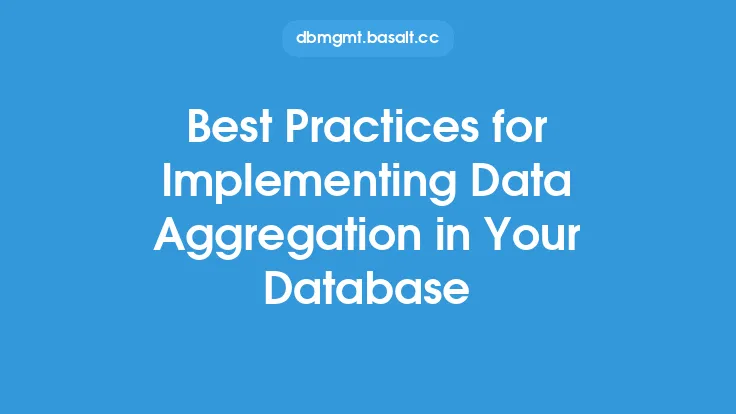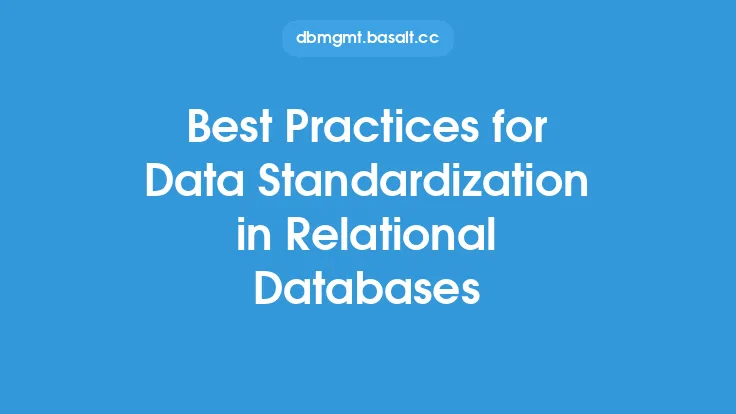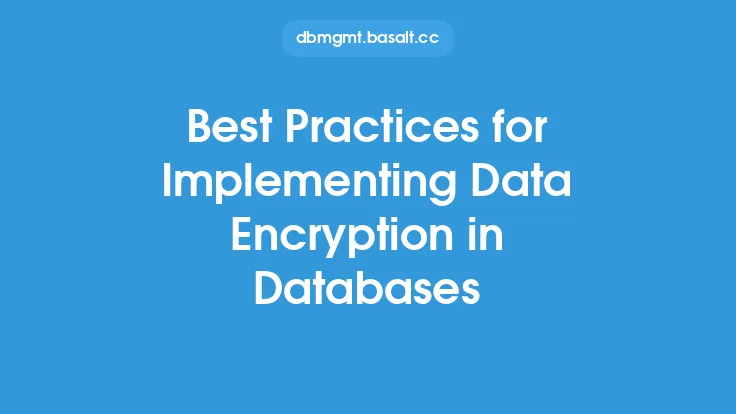Implementing data aggregation in relational databases is a crucial aspect of data denormalization, as it enables the efficient retrieval and analysis of large datasets. Data aggregation involves the process of combining and summarizing data from multiple tables or rows into a single output, which can be used to support business intelligence, data analysis, and decision-making. In this article, we will discuss the best practices for implementing data aggregation in relational databases, focusing on the technical aspects and evergreen information that remains relevant over time.
Introduction to Data Aggregation Techniques
Data aggregation techniques are used to combine data from multiple sources into a single output. There are several types of data aggregation techniques, including rollup, drill-down, and grouping. Rollup involves aggregating data from multiple rows into a single row, while drill-down involves aggregating data from a single row into multiple rows. Grouping involves aggregating data from multiple rows into a single group based on a common attribute. Understanding these techniques is essential for implementing data aggregation in relational databases.
Designing the Database Schema for Data Aggregation
When designing a database schema for data aggregation, it is essential to consider the types of queries that will be executed and the data that will be aggregated. A well-designed database schema should include tables that are optimized for data aggregation, such as summary tables and aggregate tables. Summary tables contain pre-aggregated data, which can be used to support fast query performance, while aggregate tables contain raw data that can be aggregated on the fly. Additionally, the database schema should include indexes and constraints that support data aggregation, such as primary keys and foreign keys.
Choosing the Right Data Aggregation Functions
Relational databases provide a range of data aggregation functions, including SUM, AVG, MAX, MIN, and COUNT. Choosing the right data aggregation function depends on the type of data being aggregated and the desired output. For example, the SUM function is used to calculate the total value of a column, while the AVG function is used to calculate the average value of a column. Additionally, some databases provide advanced data aggregation functions, such as GROUPING SETS and ROLLUP, which can be used to perform complex data aggregation operations.
Optimizing Data Aggregation Queries
Optimizing data aggregation queries is crucial for improving query performance and reducing the load on the database. There are several techniques that can be used to optimize data aggregation queries, including indexing, caching, and materialized views. Indexing involves creating indexes on columns that are used in data aggregation queries, which can improve query performance by reducing the number of rows that need to be scanned. Caching involves storing pre-aggregated data in memory, which can improve query performance by reducing the number of queries that need to be executed. Materialized views involve storing pre-aggregated data in a physical table, which can improve query performance by reducing the number of queries that need to be executed.
Handling Data Aggregation Errors and Exceptions
Data aggregation errors and exceptions can occur due to a range of reasons, including data inconsistencies, query errors, and system failures. Handling data aggregation errors and exceptions is crucial for ensuring data accuracy and reliability. There are several techniques that can be used to handle data aggregation errors and exceptions, including error logging, error handling, and data validation. Error logging involves logging errors and exceptions, which can be used to diagnose and resolve issues. Error handling involves catching and handling errors and exceptions, which can be used to prevent data inconsistencies and system failures. Data validation involves validating data before aggregation, which can be used to prevent data inconsistencies and errors.
Best Practices for Implementing Data Aggregation
Implementing data aggregation in relational databases requires careful planning and design. There are several best practices that can be followed to ensure successful implementation, including:
- Designing a database schema that is optimized for data aggregation
- Choosing the right data aggregation functions
- Optimizing data aggregation queries
- Handling data aggregation errors and exceptions
- Testing and validating data aggregation results
- Documenting data aggregation processes and procedures
By following these best practices, organizations can ensure that their data aggregation implementation is successful and provides accurate and reliable results.
Conclusion
Implementing data aggregation in relational databases is a complex process that requires careful planning and design. By understanding data aggregation techniques, designing a database schema that is optimized for data aggregation, choosing the right data aggregation functions, optimizing data aggregation queries, handling data aggregation errors and exceptions, and following best practices, organizations can ensure that their data aggregation implementation is successful and provides accurate and reliable results. Additionally, by staying up-to-date with the latest trends and technologies in data aggregation, organizations can ensure that their implementation remains relevant and effective over time.





